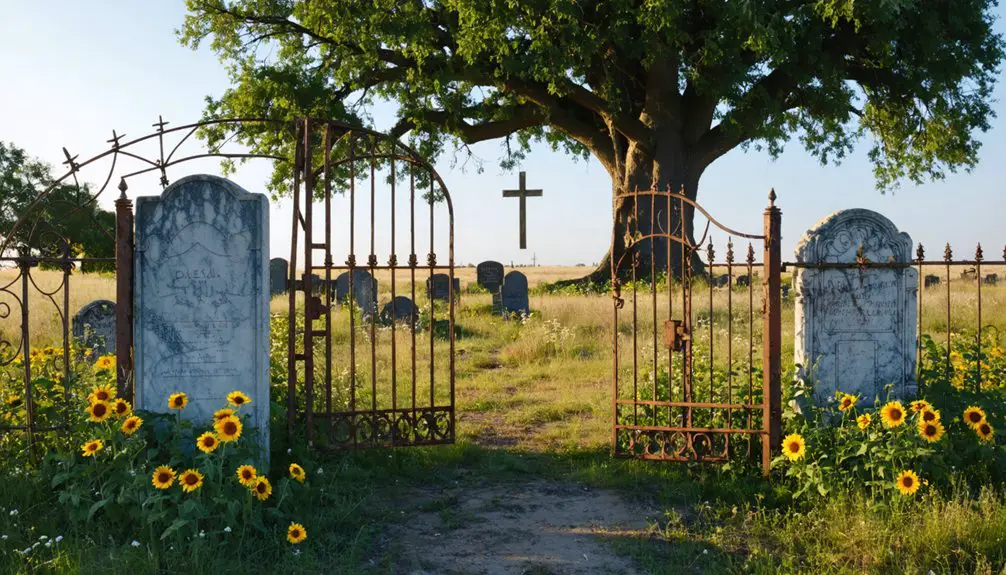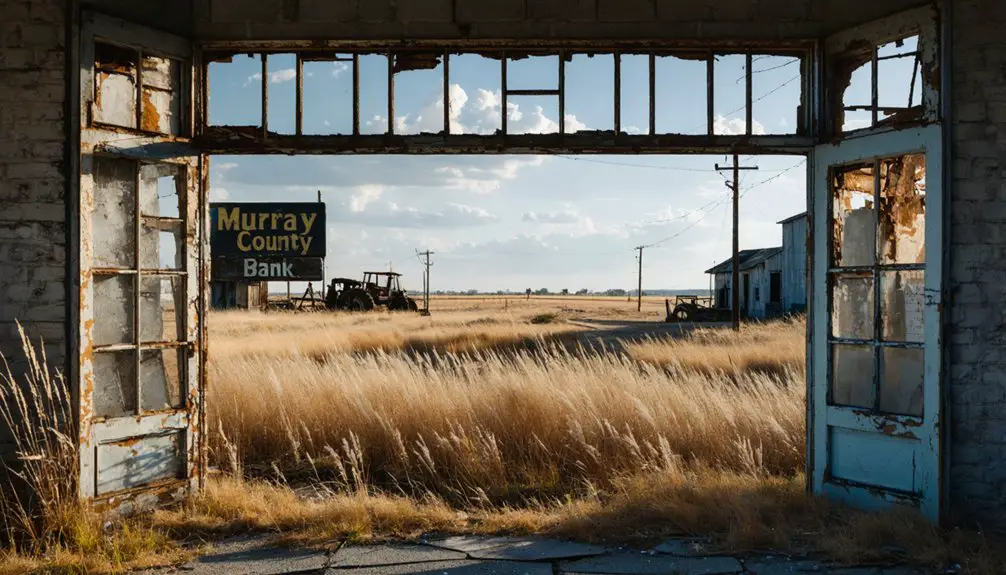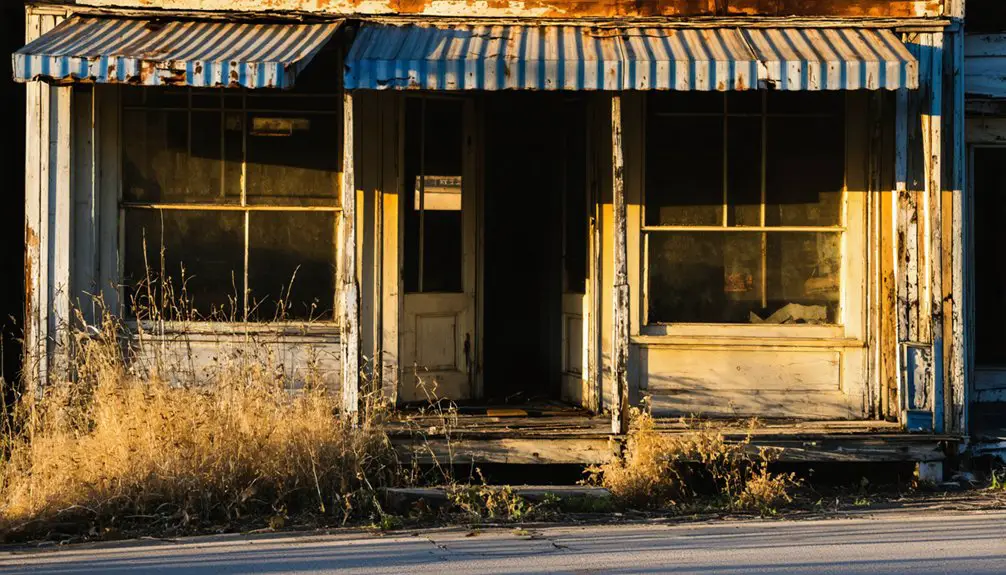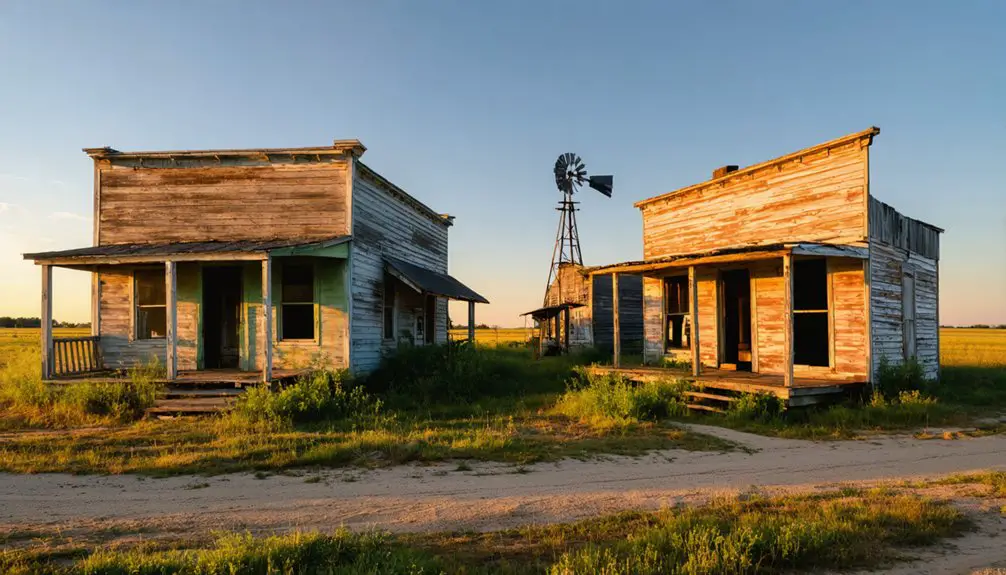You’ll find Big Canyon nestled in Oklahoma’s Arbuckle Mountains, established in 1886-87 by the Atchison, Topeka, and Santa Fe Railway for limestone quarrying. The Dolese Brothers Company transformed it into an industrial hub in 1902, pioneering ready-mix concrete production by 1927. While the town supported quarry operations until 1993, today only the Big Canyon Cemetery remains as a memorial to this once-thriving company settlement, where countless stories of early mining life await discovery.
Key Takeaways
- Big Canyon emerged as a limestone quarrying town in 1886, established by the Atchison, Topeka, and Santa Fe Railway in Murray County, Oklahoma.
- The town functioned as a company settlement with worker housing until its closure in 1993, when quarrying operations ceased.
- Today, most original structures have been removed or relocated, with the Big Canyon Cemetery remaining as the primary historical marker.
- The site’s location is approximately 5 miles southeast of Dougherty along the Washita River’s east bank in Oklahoma.
- The abandoned town’s legacy lives through its cemetery, which documents the lives of quarry workers and their families.
Origins in the Arbuckle Mountains
Nestled within the ancient Arbuckle Mountains of south-central Oklahoma, Big Canyon emerged as a settlement deeply connected to its geological significance.
Like its namesake canyon in British Columbia, this Oklahoma site shared similar geographical features that made it valuable for development.
These billion-year-old mountains, composed of granite and gneiss cores overlaid with sedimentary rocks, provided the perfect foundation for the town’s primary purpose.
Ancient granite and gneiss mountains, blanketed by layers of sedimentary rock, created the ideal base for Big Canyon’s industrial destiny.
Located in Murray County, the site sat within the mountain range that spans approximately 35 miles east to west.
You’ll find Big Canyon’s origins directly tied to the mountain range’s mineral wealth, specifically its abundant limestone deposits.
The Atchison, Topeka, and Santa Fe Railway established the settlement in 1886-87 to quarry crushed limestone for railroad construction.
The town’s strategic location along the East bank of the Washita River, where the waterway carved a 350-foot-deep canyon through the mountains, made it ideal for mining operations.
This geological setting proved essential for both the town’s establishment and its role in regional development.
The Dolese Brothers’ Legacy
While the history of Big Canyon stretches back to 1886, it was the arrival of the Dolese Brothers Company in 1902 that transformed the settlement into a thriving industrial hub.
The brothers’ innovations revolutionized quarry operations and set new standards for the industry across Oklahoma and beyond. The company began by providing ballast for railroads before expanding their operations significantly. They purchased a second quarry in Murray County in 1908 to meet growing demand.
Their lasting impact on Big Canyon and Oklahoma’s development includes:
- Establishing extensive quarry safety protocols decades before they were mandated
- Creating a self-sufficient company town with worker housing and essential facilities
- Pioneering ready-mix concrete production in 1927, diversifying beyond crushed stone
- Leading environmental stewardship through land reclamation and sustainable practices
You can still see the Dolese brothers’ influence today through their reclaimed quarries, like the Dolese Youth Park, and their company’s continued leadership in construction materials throughout Oklahoma.
Railroad’s Role in Town Development
As the first major railroad to cross Indian Territory in 1870, the Missouri, Kansas and Texas Railroad (MKT or Katy) set the stage for Big Canyon’s industrial development.
The railroad expansion that followed brought the Santa Fe line through the Arbuckle Mountains in 1886, creating economic incentives that would shape Big Canyon’s destiny.
You’ll find that Big Canyon’s very existence stemmed from the Santa Fe Railroad’s need for crushed limestone to build its rail bed through challenging terrain.
Despite early legal challenges and protests from Indians regarding land grants, the railroads pushed forward with their expansion plans through the territory.
The town quickly developed into a company settlement, complete with worker dormitories and housing for Santa Fe employees.
This industrial partnership between the railroad and limestone quarry operations lasted from 1886 until 1993, demonstrating how railroad infrastructure demands could sustain a community for over a century.
Life in a Limestone Company Town
You’d find quarry workers at Big Canyon starting their days with intense manual labor, hand-drilling blast holes and loading blasted rock before technological advances brought more mechanization.
Your housing options as a worker would have been limited to one of eight company-owned homes for families or a spot in the dormitory for single men, with basic amenities provided through the company commissary and cookhouse.
Social life centered around these communal spaces, where you’d interact with both permanent family residents and transient laborers who kept the limestone operation running. The quarry operations continued successfully producing Santa Fe railroad ballast until 1993 when alternative materials were adopted.
The town’s location in southeastern Oklahoma placed it strategically near major transportation routes for distributing quarried materials.
Daily Quarry Worker Routines
From sunrise to sunset, the demanding routines of Big Canyon’s quarry workers revolved around extracting and processing limestone through physically intensive labor.
You’d find these hardy workers enduring harsh labor conditions while facing constant safety risks from explosives, heavy machinery, and falling rock hazards.
Your typical workday in the quarry would include:
- Manual drilling and packing blast holes with black powder for controlled explosions
- Loading fragmented limestone by hand into mine cars initially pulled by mules
- Operating mechanical drills and pneumatic tools as technology advanced
- Coordinating with railroad schedules to maintain steady limestone deliveries
Working 8-10 hour shifts, you’d brave the constant exposure to dust and deafening noise from blasting and crushing operations, all while maintaining the critical flow of materials needed for railroad construction and maintenance.
Much like the diverse Oklahoma landscape that surrounded them, the quarry operations adapted to various terrains, from flat prairies to mountainous regions, requiring different extraction techniques.
Housing and Social Structure
While operating as a classic limestone company town, Big Canyon’s social fabric was tightly woven around the Dolese Brothers’ control of housing and community facilities.
You’d find about eight company-owned houses, with distinct social hierarchy evident in the separate dormitory for single male workers. The company’s grip extended through every aspect of daily life – from the commissary where you’d buy supplies to the cookhouse where you’d eat your meals.
Through this system of company control, you’d experience a tightly regulated environment where your housing, social connections, and economic opportunities were inseparable from your employment. Springwater piped to houses made living conditions slightly more bearable for residents.
The post office served as a community hub until 1961, while the employee cemetery symbolized the permanent yet confined nature of life within this industrial settlement.
Big Canyon Cemetery and Local Stories

As one of the few remaining physical landmarks of Big Canyon’s history, the town’s cemetery stands as a solemn memorial to the quarry workers who built their lives around the Dolese Brothers’ operations.
Cemetery folklore tells of unmarked graves and regular family visits even after the town’s abandonment, while grave maintenance remains an ongoing challenge due to natural weathering and limited preservation efforts. Much like the historic Cave House in Tulsa, the site holds its share of paranormal reports from visitors who claim to experience unexplained phenomena.
You’ll find these notable aspects of the cemetery’s significance:
- Documents the dangerous nature of early limestone quarry work through burial records
- Reflects the community dynamics of a company town dependent on quarry employment
- Provides insight into worker demographics of early 20th-century rural Oklahoma
- Serves as a tribute to laborers who supported Santa Fe Railroad construction through the Arbuckles
Architecture and Infrastructure
You’ll find the railroad housing in Big Canyon was decidedly utilitarian, consisting of roughly eight modest worker homes and a dormitory built to accommodate single quarry laborers.
The residential structures, constructed by or for employees of the Dolese Brothers quarry operation, reflected the industrial purpose of the settlement through their basic, functional design.
The housing was eventually relocated after the post office closed in 1961, leaving no significant preserved residential architecture at the original site today.
Railroad Housing Design
Through its distinctive blend of Native American and Spanish influences, Big Canyon’s railroad housing exemplified the practical architectural approaches common to Southwest railway settlements. The modest structures prioritized functional, communal living spaces while incorporating regional cultural influences in their design elements.
The railroad housing design featured four key characteristics:
- Strategic clustering near quarries and rail yards to maximize worker accessibility
- Combination of family units and dormitory-style accommodations with shared facilities
- Integration of porches and terraces for climate adaptation and social gathering
- Simple structural forms with pitched roofs and strategically placed windows for ventilation
These dwellings reflected the rugged landscape, with their placement and construction techniques carefully chosen to withstand harsh weather while maintaining operational efficiency for the railroad community.
Construction Materials Used
The construction materials used in Big Canyon reflected a practical blend of locally sourced resources and period-specific building techniques.
You’ll find that limestone from the Dolese Brothers’ quarry served as the cornerstone of the town’s infrastructure, particularly in railroad construction where quarry materials were essential for track beds and grade formation.
While the residential structures primarily consisted of wood-frame construction, many buildings featured stone foundations typical of the era.
The town’s construction techniques balanced durability with utility, as evidenced by the eight houses built for railroad and quarry workers.
You’ll notice that commercial structures and ancillary facilities likely incorporated both wood and stone elements, while the cemetery showcased carved stone markers.
This mix of materials demonstrates Big Canyon’s reliance on readily available resources for its development.
Economic Impact on Murray County

During its operational peak, Big Canyon’s quarrying industry served as an essential economic engine for Murray County, generating substantial employment and revenue streams.
The quarrying legacy extended beyond direct jobs, supporting ancillary businesses and infrastructure development throughout the region.
You’ll find Big Canyon’s economic impact reflected in these key areas:
- Production of high-strength crushed stone for railroad ballast and construction
- Creation of jobs in transport and equipment maintenance services
- Generation of tax revenue supporting county development
- Establishment of Murray County as a recognized source of quality stone products
Today, this once-thriving industrial center stands as a ghost town economics case study, demonstrating how the decline of extractive industries can transform local communities.
While tourism potential exists, the area’s shift from industrial powerhouse to historical site represents a significant change in Murray County’s economic landscape.
Daily Operations at the Quarry
While Big Canyon’s daily quarry operations evolved over time, core activities centered on a labor-intensive process of limestone extraction and processing.
You’d find workers drilling blast holes by hand, packing them with black powder, and carefully executing controlled explosions to free the limestone. After blasting, laborers loaded the broken stone onto mule-drawn mine cars for transport to the crushing facilities.
Shift work guaranteed continuous stone processing and quarry maintenance throughout the day, with crews focusing on meeting Santa Fe Railroad‘s demanding ballast requirements.
Workers lived in company housing nearby, enabling quick responses to production needs. The dangerous nature of the work was evident in the presence of an on-site cemetery for deceased employees.
This labor-intensive operation continued until modern industry changes led to the quarry’s closure in 1993.
The Town’s Gradual Disappearance

As Big Canyon’s economic foundation eroded in the mid-20th century, this once-vital quarry settlement began its steady march toward abandonment.
The community decline accelerated as economic shifts reduced demand for limestone, leading to dramatic changes you’d have witnessed in this isolated town.
The sequence of Big Canyon’s disappearance followed these key events:
- Post office closure in 1961 marked the end of official community status
- Dolese Brothers relocated all buildings after the closure
- Housing and community facilities were systematically dismantled
- Final quarry shutdown in 1993 sealed the town’s fate
What remains today is primarily the Big Canyon Cemetery, a solitary reminder of the community that once thrived in this rugged corner of the Arbuckle Mountains.
The town’s transformation from an active quarry settlement to a ghost town reflects the broader pattern of industrial changes in rural Oklahoma.
Modern-Day Site and Historical Preservation
Today you’ll find Big Canyon‘s original site along the Washita River‘s east bank, about 5 miles southeast of Dougherty, Oklahoma, though most structures have been removed or relocated since the quarry’s 1993 closure.
While the Big Canyon Cemetery remains as a historical marker, you’ll need to rely on GPS coordinates and historical maps to identify specific locations within the former town.
The site’s documentation exists primarily through archival records about the Dolese Brothers’ operations and local historical society collections, though no formal historic landmark designation exists.
Remnants and Access Today
Despite its rich industrial heritage, Big Canyon‘s physical remnants primarily consist of the original Dolese Brothers quarry and a historic cemetery where workers were buried.
If you’re planning to visit, you’ll find the site is generally accessible, though you may need permission to explore quarry property areas. Due to quarry safety concerns and rugged Arbuckle Mountain terrain, careful navigation is essential.
Key aspects of today’s site include:
- No permanent structures remain, as buildings were relocated after the 1993 closure.
- Inactive railroad tracks have been removed from the former mining operations.
- Natural reclamation is ongoing, though industrial scars remain visible.
- No visitor facilities or interpretive signage exists to guide your exploration.
The cemetery serves as the most tangible connection to Big Canyon’s mining community history.
Historical Documentation Efforts
The preservation of Big Canyon’s history relies heavily on systematic documentation efforts spanning multiple sources and methodologies. You’ll find detailed records in post office logs dating from 1904-1961, alongside extensive Dolese Brothers quarry documentation tracking operations until 1993. The archival significance of these materials provides vital insights into the town’s industrial heritage.
Local historical societies actively maintain Big Canyon’s historical narratives through digital archives, field surveys, and cemetery register preservation.
Academic researchers contribute through interdisciplinary studies, combining geological data with community development analysis. At coordinates 34°21′44.2″N 97°1′38.98″W, ongoing site documentation includes GPS mapping, photographic surveys, and oral histories from quarry workers’ descendants, ensuring that Big Canyon’s role in Oklahoma’s mining and railroad development remains accessible for future study.
Frequently Asked Questions
Were There Any Major Accidents or Deaths Reported at the Quarry?
Picture a dusty limestone quarry where safety records are sparse. You won’t find major documented tragic incidents, though the quarry’s dedicated cemetery suggests some workers died during its century-long operation.
What Happened to the Machinery and Equipment After the Quarry Closed?
You’ll find most quarry equipment was removed in 1993, with machinery likely sold, recycled, or salvaged by specialized companies. Some abandoned machinery may have been dismantled for scrap metal disposal.
Did Native American Artifacts Surface During Quarrying Operations?
You can’t confirm definitive artifact discovery during quarrying operations, though the area’s rich indigenous history suggests findings were possible. Available records don’t document any specific Native American artifacts being unearthed.
Were There Any Schools or Churches Established in Big Canyon?
While a million records were searched, you won’t find any school history or church significance here – there’s no evidence that either institution was established in this limestone quarry company town.
What Was the Highest Recorded Population of Big Canyon During Its Peak?
You won’t find an officially recorded peak population, but based on the town’s eight houses and worker dormitory, population growth likely maxed at 100-200 before town decline began.
References
- https://okgenweb.net/~okmurray/Murray/communities/big_canyon.htm
- https://en.wikipedia.org/wiki/List_of_ghost_towns_in_Oklahoma
- https://en.wikipedia.org/wiki/Big_Canyon
- https://kids.kiddle.co/List_of_ghost_towns_in_Oklahoma
- https://www.okhistory.org/publications/enc/entry?entry=MU011
- https://en.wikipedia.org/wiki/Arbuckle_Mountains
- https://www.redriverhistorian.com/post/fort-arbuckle-in-the-mountains
- https://www.okhistory.org/publications/enc/entry?entry=AR004
- https://www.southwestledger.news/news/doleses-history-sooner-state
- https://journalrecord.com/2020/02/14/strong-foundation-legacy-of-dolese-bros-co-set-in-oklahoma-stone/



